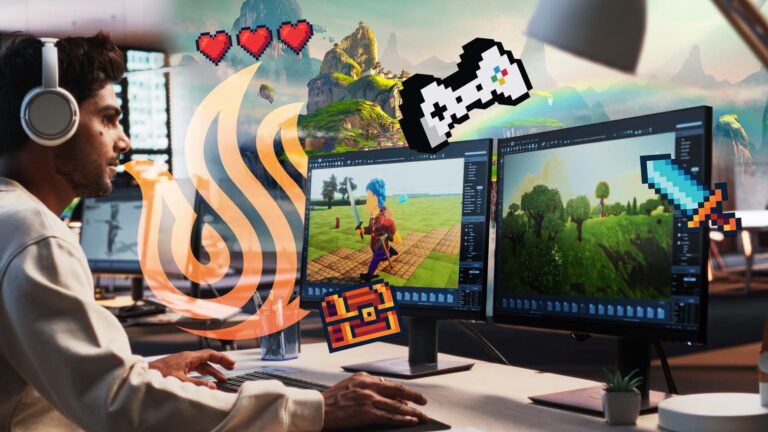If you have been around tech circles recently you will have undoubtedly heard a great deal of enthusiasm and anticipation for the next generation of immersive entertainment. Both the virtual reality and augmented reality industries have seen a massive resurgence featuring several tech giants pushing the medium forward. Aspiring animators want to learn how to join this exciting new frontier. Making either virtual or augmented reality your specialty will absolutely make you valuable. So, where can you learn about virtual and augmented reality?
Where Can You Learn About Virtual and Augmented Reality?
Virtual and augmented reality programs rely on innovative and experimental technologies. The best way to learn about virtual and augmented reality is by attending a future-forward creative arts college. Specifically, you can enroll in a bachelor’s degree program in Digital Arts and Animation. Since the most important components of animation are covered in these degree programs, you will learn a great deal about both VR and AR technologies.
What is Augmented Reality (AR)?
As the name implies, augmented reality uses technology to enhance the user’s perception of the world around them. Technology such as holograms overlay digital images on top of real-world environments. The result is a composite view that considers both real life and digital assets created by artists. A prime example of augmented reality is the popular mobile game, Pokémon Go. In this title, augmented reality versions of Pokémon appear in your surroundings when you point your phone at a specific location. In this case, the phone’s camera projects the image of each creature into the world.
Assisted Reality
While your mind may think about entertainment when considering AR, the technology has a variety of other utilitarian uses. Assisted reality offers useful information readouts that help users navigate their environment or solve problems. The most obvious example is augmented reality text that appears above objects in your community. In addition to object descriptions, a translation overlay could also convert real-world text into other languages by imposing digital words over the original writing.
Computer Vision
This technology refers to the methods augmented reality devices use to scan and interpret the physical environment around the user. By examining various features and patterns of real-world objects, computers can determine what they are looking at and offer additional layers of content to the user. This allows the augmented reality device to display the proper images and assets for the user to view.
Cloud Recognition
Storing the visual data for millions of real objects would not be feasible without the help of cloud storage. To efficiently account for the vast number of objects, augmented reality designers use cloud recognition to quickly find information about each object scanned with Computer Vision. Both technologies work in tandem to analyze your surroundings and produce the rational response based on the software or app on your smartphone.
Holograms
Holographic light projections on a flat surface are the basic makeup for augmented reality programs. Holograms can produce both 2D and 3D images that appear real, despite being comprised of fully digitized assets. While you do not need an augmented reality device to see holograms, they can further enhance the visual effect.
What is Virtual Reality (VR)?
Virtual reality completely immerses the user in a digital world. This effect is achieved using a headset, which completely obscures the user’s perception of the real world around them. Once you place the headset on, the goal is to completely forget the actual world and trick your mind into thinking the virtual reality program is real. A popular example of VR is the game, Half Life Alyx. This video game was built exclusively for VR headsets. In general, programs designed specifically for virtual reality will perform better than existing software with VR support added in later.
Motion Platform
Most virtual reality programs feature a character or camera that the user can manipulate. The motion platform captures your movements and applies them to your character in this virtual space. In some instances, wearable equipment can precisely track the movement of each limb. The goal is to faithfully represent every possible motion the user could make while engaged in a VR simulation.
Eye and Head Tracking
Since most virtual reality software utilizes a headset, extensive eye and head tracking are the cornerstones of creating an immersive environment. Tracking where the user’s head is positioned is instrumental in establishing the view on the virtual reality screen. The image is even more accurate using eye tracking. By observing your eyes, a VR platform captures your sight path. This allows the program to keep you immersed in a believable setting.
Refresh Rate
This core component of screen technology is even more crucial when designing VR software. The refresh rate refers to how fast the image on a screen updates. It is measured by the number of times the screen refreshes in one second. Since your eyes constantly relay new information to your brain, the refresh rate on VR headsets must be incredibly smooth to emulate your natural ability.
Field of View
The field of view in virtual reality measures how many degrees the camera allows the user to see in front of them. The human eye can perceive images in a 200-degree angle around its head. Achieving immersion requires getting as close to a 200-degree field of view as possible. Of course, an increased field of view can hamper performance and reduce refresh rate. Thus, immersive VR experiences rely on the balance between field of view and refresh rate to achieve maximum performance.
How Do You Create Virtual and Augmented Reality?
There are several key factors that go into modern VR and AR production. The high cost of these specialty tools establish even more incentive to attend a creative arts college. Schools that specialize in tech will have the VR and AR tools you need to explore these interesting new fields.
Game Engines
While not all VR and AR programs need to be games, both technologies lend themselves incredibly well to the interactive medium. Video games are created in special programs called game engines. Common game engines include Unreal and Unity. Both tools can create fully realized digital worlds and the characters that interact in them. Since game engines get constant update support from developers, you can expect popular engines to increase their focus on VR and AR in the years to come.
Apps and Other Software
Many other types of software can be useful for VR or AR production. Animation tools such as Blender or Maya are the most common examples. You also have text editors, version control software, and cloud storage solutions.
Computing Hardware
Running advanced VR or AR programs requires an advanced hardware rig to obtain stable performance. When searching for hardware that matches these specs, you need computers that are designated workstations. These devices include a lot of RAM, lightning-fast SSDs, a responsive CPU, and two top of the line graphics cards. The expensive cost of rigs like this makes enrolling in a creative arts college even more appealing.
VR Headsets
Virtual reality programs can completely immerse the user. This is achieved using a headset, which covers your face with a digital screen. The loss of normal vision helps create the VR illusion. VR headsets can be accompanied by special controllers and equipment to set the boundaries of your room. Determining which VR headsets to support is a key part of the production cycle.
What Else Do You Learn About in a Digital Arts & Animation Program?
Enrolling in a digital arts and animation program provides a comprehensive education that covers the many aspects of the animation pipeline and software development cycles. By the end of the curriculum, you will be prepared to work in junior roles throughout the industry.
3D Animation Principles
The core of your training will focus on the principles that successful animators have established and studied for years. You will learn the popular techniques that fueled some of the all-time classic animation projects. This foundational knowledge enhances your skill and sets you up for success as you start working at animation studios.
Storyboarding
Before starting an animation project, artists carefully plan each scene out on paper. Storyboards look like simple comic strips that are easy for everyone on the team to understand. The goal of a storyboard is to convey the basic tone and ideas that each animator will work on. The storyboard keeps everyone on the same page as the real assets for the project are created and finalized. You will refer to these simple hand drawn images throughout the course of each production you collaborate on.
Animated Film Production
Even if you are not going into film, the techniques used to make films fuel the animation paths you can explore. Cartoons are just short movies, and modern video games often incorporate just as many cinematic elements as blockbuster films. You will discover how to produce films from start to finish, so you can recreate the same pipeline in your own projects. Mastering the basic templates provided throughout the curriculum will teach you how to tell stories through the art of animation.
Want to Learn More?
Interested in learning more about virtual and augmented reality? If your passion is for visual effects, 2D or 3D animation, or concept art for video games or blockbuster films, this is the Digital Arts & Animation degree program for you. Gain the digital arts and animation skills you need to kick off your career in this dynamic and growing industry.
University of Silicon Valley is uniquely poised to offer a meaningful and valuable education for 21st century students. We believe in an education that directly correlates with the work you’ll be doing after you graduate. Interested in learning more? Contact Us today.


